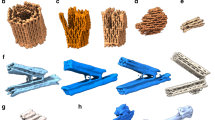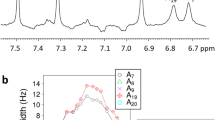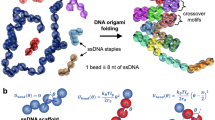Abstract
The microscopic flexibility of DNA is a key ingredient for understanding its interaction with proteins and drugs but is still poorly understood and technically challenging to measure. Several experimental methods probe very long DNA samples, but these miss local flexibility details. Others mechanically disturb or modify short molecules and therefore do not obtain flexibility properties of unperturbed and pristine DNA. Here, we show that it is possible to extract very detailed flexibility information about unmodified DNA from melting temperatures with statistical physics models. We were able to retrieve, from published melting temperatures, several established flexibility properties such as the presence of highly flexible TATA regions of genomic DNA and support recent findings that DNA is very flexible at short length scales. New information about the nanoscale Na+ concentration dependence of DNA flexibility was determined and we show the key role of ApT and TpA steps when it comes to ion-dependent flexibility and melting temperatures.
This is a preview of subscription content, access via your institution
Access options
Subscribe to this journal
Receive 12 print issues and online access
$209.00 per year
only $17.42 per issue
Buy this article
- Purchase on Springer Link
- Instant access to full article PDF
Prices may be subject to local taxes which are calculated during checkout



Similar content being viewed by others
References
Wilkins, M. H. F., Gosling, R. G. & Seeds, W. E. Nucleic acid: An extensible molecule? Nature 167, 759–760 (1951).
Watson, J. D. & Crick, F. H. C. Molecular structure of nucleic acids: A structure for deoxyribose nucleic acid. Nature 171, 737–738 (1953).
Ritort, F. Single-molecule experiments in biological physics: Methods and applications. J. Phys. Condens. Matter 18, R531–R583 (2006).
Wiggins, P. A. et al. High flexibility of DNA on short length scales probed by atomic force microscopy. Nature Nanotech. 1, 137–141 (2006).
Yuan, C., Chen, H., Lou, X. W. & Archer, L. A. DNA bending stiffness on small length scales. Phys. Rev. Lett. 100, 018102 (2008).
Mathew-Fenn, R. S., Das, R. & Harbury, P. A. B. Remeasuring the double helix. Science 322, 446–449 (2008).
Marilley, M., Sanchez-Sevilla, A. & Rocca-Serra, J. Fine mapping of inherent flexibility variation along DNA molecules. validation by atomic force microscopy (AFM) in buffer. Mol. Genet. Genomics 274, 658–670 (2005).
Olson, W. K., Gorin, A. A., Lu, X.-J., Hock, L. M. & Zhurkin, V. B. DNA sequence-dependent deformability deduced from protein–DNA crystal complexes. Proc. Natl Acad. Sci. USA 95, 11163–11168 (1998).
Yamakawa, H. & Stockmayer, W. H. Statistical mechanics of wormlike chains. II. Excluded volume effects. J. Chem. Phys. 57, 2843–3854 (1972).
Shimada, J. & Yamakawa, H. Ring-closure probabilities for twisted wormlike chains. Application to DNA. Macromolecules 17, 689–698 (1985).
Cloutier, T. E. & Widom, J. DNA twisting flexibility and the formation of sharply looped protein–DNA complexes. Proc. Natl Acad. Sci. USA 102, 3645–3650 (2005).
Richard, C. & Guttmann, A. J. Poland–Scheraga models and the DNA denaturation transition. J. Stat. Phys. 115, 925–947 (2004).
Peyrard, M. & Bishop, A. R. Statistical mechanics of a nonlinear model for DNA denaturation. Phys. Rev. Lett. 62, 2755–2757 (1989).
Weber, G. et al. Thermal equivalence of DNA duplexes without melting temperature calculation. Nature Phys. 2, 55–59 (2006).
Weber, G., Haslam, N., Essex, J. W. & Neylon, C. Thermal equivalence of DNA duplexes for probe design. J. Phys. Condens. Matter 21, 034106 (2009).
Zhang, Y.-L., Zheng, W.-M., Liu, J.-X. & Chen, Y. Z. Theory of DNA melting based on the Peyrard–Bishop model. Phys. Rev. E 56, 7100–7115 (1997).
Owczarzy, R. et al. Effects of sodium ions on DNA duplex oligomers: Improved predictions of melting temperatures. Biochemistry 43, 3537–3554 (2004).
Barry Starr, D., Hoopes, B. C. & Hawley, D. K. DNA bending is an important component of site-specific recognition by the TATA binding protein. J. Mol. Biol. 250, 434–446 (1995).
Grove, A., Galeone, A., Mayol, L. & Geiduschek, E. P. Localized DNA flexibility contributes to target site selection by DNA-bending proteins. J. Mol. Biol. 260, 120–125 (1996).
Lebrun, A., Shakked, Z. & Lavery, R. Local DNA stretching mimics the distortion caused by the TATA box-binding protein. Proc. Natl Acad. Sci. USA 94, 2993–2998 (1997).
de Souza, O. N. & Ornstein, R. L. Inherent DNA curvature and flexibility correlate with TATA box functionality. Biopolymers 46, 403–415 (1998).
Breslauer, K. J., Frank, R., Blocker, H. & Marky, L. A. Predicting DNA duplex stability from the base sequence. Proc. Natl Acad. Sci. USA 83, 3746–3750 (1986).
SantaLucia, J. Jr, Allawi, H. T. & Seneviratne, P. A. Improved nearest-neighbour parameters for predicting DNA duplex stability. Biochemistry 35, 3555–3562 (1996).
Dauxois, T., Peyrard, M. & Bishop, A. R. Entropy-driven DNA denaturation. Phys. Rev. E 47, R44–R47 (1993).
Weber, G. Sharp DNA denaturation due to solvent interaction. Europhys. Lett. 73, 806–811 (2006).
Campa, A. & Giansanti, A. Experimental tests of the Peyrard–Bishop model applied to the melting of very short DNA chains. Phys. Rev. E 58, 3585–3588 (1998).
Hamelberg, D., McFail-Isom, L., Williams, L. D. & Wilson, W. D. Flexible structure of DNA: Ion dependence of minor-groove structure and dynamics. J. Am. Chem. Soc. 122, 10513–10520 (2000).
Stellwagen, N. C., Magnusdottir, S., Gelfi, C. & Righetti, P. G. Preferential counterion binding to A-tract DNA oligomers. J. Mol. Biol. 305, 1025–1033 (2001).
Mocci, F. & Saba, G. Molecular dynamics simulations of A·T-rich oligomers: Sequence-specific binding of Na+ in the minor groove of B-DNA. Biopolymers 68, 471–485 (2003).
Stefl, R., Wu, H., Ravindranathan, S., Sklenar, V. & Feigon, J. DNA A-tract bending in three dimensions: Solving the dA4T4 vs dT4A4 conundrum. Proc. Natl Acad. Sci. USA 101, 1177–1182 (2004).
Cocco, S. & Monasson, R. Statistical mechanics of torque induced denaturation of DNA. Phys. Rev. Lett. 83, 5178–81 (1999).
Seol, Y., Li, J., Nelson, P. C., Perkins, T. T. & Betterton, M. D. Elasticity of short DNA molecules: Theory and experiment for contour lengths of 0.6–7 μm. Biophys. J. 93, 4360–4373 (2007).
Kim, J.-Y., Jeon, J.-H. & Sung, W. A breathing wormlike chain model on DNA denaturation and bubble: Effects of stacking interactions. J. Chem. Phys. 128, 055101 (2008).
Kalosakas, G., Rasmussen, K. O., Bishop, A. R., Choi, C. H. & Usheva, A. Sequence-specific thermal fluctuations identify start sites for DNA transcription. Europhys. Lett. 68, 127–133 (2004).
Acknowledgements
We acknowledge financial support by Fapemig and CNPq. G.W. would like to thank R. Guerra-Sá for helpful discussions on TATA-box binding proteins.
Author information
Authors and Affiliations
Contributions
G.W. conceived the method and carried out the calculation. C.N. and J.W.E. contributed with the biochemical interpretation of the data and gave conceptual advice. All authors wrote the paper.
Corresponding author
Supplementary information
Supplementary Information
Supplementary Information (PDF 286 kb)
Rights and permissions
About this article
Cite this article
Weber, G., Essex, J. & Neylon, C. Probing the microscopic flexibility of DNA from melting temperatures. Nature Phys 5, 769–773 (2009). https://doi.org/10.1038/nphys1371
Received:
Accepted:
Published:
Issue Date:
DOI: https://doi.org/10.1038/nphys1371
This article is cited by
-
Optical and theoretical study of strand recognition by nucleic acid probes
Communications Chemistry (2020)
-
Origin of multiple periodicities in the Fourier power spectra of the Plasmodium falciparum genome
BMC Genomics (2011)



